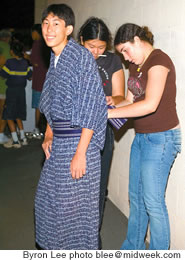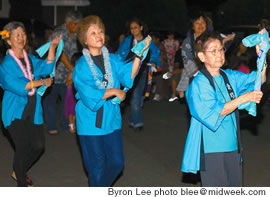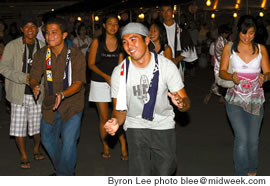Bon Dancing The Summer Away
It’s historic, it’s cultural, it’s religious, and most of all it’s a fun part of Hawaii culture. MidWeek’s intrepid reporter goes out to experience bon dancing, and offers a few bon mots on the subject

Luke Wadahara gets a hand with his
yutaka from Christine Wadahara and
Ariel Avilla
What began as a Japanese celebration for honoring ancestors has blossomed in Hawaii into a way for friends and families to enjoy each other’s company, grind on local foods and sell cultural crafts, while still paying homage to those who walked before them.
Commonly known as bon dancing, this O-Bon celebration is known by many names, including Festival of Souls, Festival of the Dead and Festival of Lanterns, which stem from past traditions of cleaning ancestor’s graves and making special chochin (lanterns) to guide their souls back to the world of the living.
More than 500 years ago, the tradition of bon dancing, or Bon Odori, originated from the story of Mokuren, who saw a vision of his dead mother in the “Realm of Hungry Ghosts,” where she was indulging in her own selfishness. Searching for a way to release his mother from this realm, Mokuren sought the help of Buddha, who said “On the 15th of July provide a big feast for the past seven generations of the dead.” Mokuren did this and his mother was released. He then saw her true unselfish nature and danced with joy, thus bon dancing was born as a way to honor ancestors and their sacrifices.

Joyce Fujishige, Dale Yamashita and Barbara Nishioka
join the dancing at Palolo
“There’s still a religious aspect, (to the dance), but it’s turned more into a neighborhood festival with arts and crafts. The Japanese believe ancestors come back to visit in the summer,” says Jeff Herman, of the Iwakuni Bon Dance Club.
All are invited to dance, by the way, you don’t have to be of Japanese descent to participate. In fact, Herman says, a lot of people who attend the events choose not to even join a club, they simply enjoy the activity.
Numerous bon dance clubs, including the Iwakuni, hold dances every weekend, beginning in June and usually ending in August. In Japan, the season lasts for two weeks. Here, it lasts all summer because so many temples and clubs are eager to participate. A set schedule is made for each new season, explains Herman, so that each temple may hold a dance without competition.
“One year we even had dances in October,” says the 15-year Iwakuni member.
Iwakuni recruiter Alan Inaba has been with the 40-year-old club for 22 years. He boasts of having members of all ages and talents.
“Our No. 1 singer, he’s 91 years old. A recording of his voice is at the Smithsonian,” says Inaba, adding that Iwakuni’s youngest member is a 13-year-old Filipino boy. “He is a tremendous dancer. He dances as well as any member of our club. I recruited him last year. We have a very talented group.”

Tyler Ito, Yusharn Wang, Leila Chen, Kyle Kiyonaga
and Karen Chou carry on a tradition with the bon
boogie
Traditionally, dances are held outside in the evening- assuming the weather cooperates, which it didn’t for the dance on July 28 at Palolo Hongwanji Mission in Kaimuki. Those pesky water droplets from the sky forced the festivities indoors. The rain, however, wasn’t enough to dampen anyone’s spirits.
Had the dance been held outside, drummers and chanters would have stood inside a yagura (small tower) in the parking lot decorated with Japanese lanterns. Dancers would be standing below, surrounding the tower in either one large circle or several concentric circles, depending on the number of people. Dancers begin moving to recorded music, usually for 20 minutes. For the next 20-minute period, drummers and chanters provide the music.
A few rearrangements were made for the indoors event. The drummers and chanters stood on the temple’s auditorium stage with dancers on the main floor, forming several circles.
With recorded music in full swing, dancers at the Palolo event begin synchronized movements while staying in their circles. Right hand on top of left. Left on top of right. Then make a circle with both hands. One hand up, the other down. Step to right, step to left. Bow down halfway with hands together. Step forward slowly and repeat.
Page 1 of 2 pages for this story 1 2 >
E-mail this story | Print this page | Comments (0) | Archive | RSS
Most Recent Comment(s):








